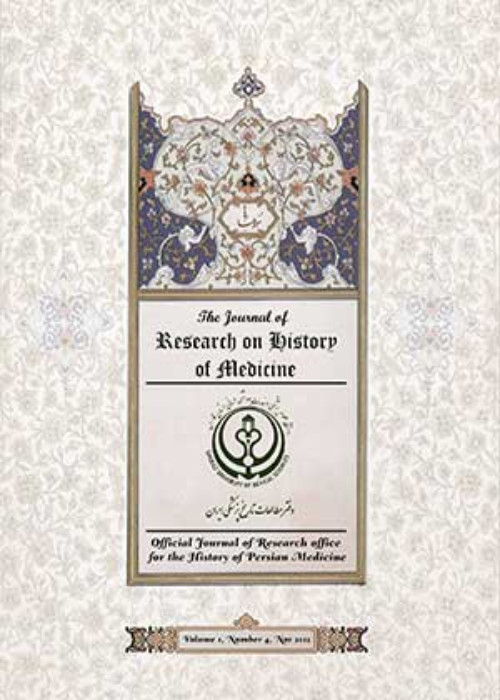فهرست مطالب
Journal of Research on History of Medicine
Volume:2 Issue: 4, Nov 2013
- تاریخ انتشار: 1392/08/11
- تعداد عناوین: 7
-
-
Page 115Many studies concerning Persian history have been performed. Persian physicians and scientists greatly contributed to medical sciences by their own observations, experimentations and skills through more than seven thousand years of Persian history. In Persian medieval medicine, different fields were described. Among these fields, neurological disorders, especially headache and epilepsy were explained in details. Medieval Persian physicians described the treatment of headache using many substances with different modes of actions. They attributed the therapeutic actions of plants to a specific analgesic, sedative or prophylactic drug property of variable strength. They also defined the epilepsy as a manifestation which begins suddenly, although premonitory symptoms, such as weakness, epigastric pressure or pain, depression, tongue paresthesia, spreading extremities paresthesia, sudden shock, incoherent speech, nightmare and sandness may start before the attacks. Medieval Persian physicians accumulated all the existing information on medicine at that time and added to this knowledge their own observations with the introduction of many new remedies. Such information provides comprehensive data on clinical treatments based on centuries of experience in the field of headache and epilepsy, and thus might help the testing of the probable benefits of these remedies for the treatment of cephalagia and epilepsy.
-
Page 129In the ancient world many scientific beliefs were rooted in religion and were shared among civilizations. One of the important commonality of two civilizations of Iran and India is the medical field, especially curative plants. «Hume» was one of these herbs which treated many diseases. This planet is called «Haoma» in «Avesta», «Soma» in Sanskrit and «Hume» in Persian. It had remedial features and was believed by both civilizations to contain water of life and immortality. Iranians used it in their rites and ceremonies. «Haoma» or «Soma» was assigned a divine role and was worshiped as a god. The extract of «Haoma» granted supernatural power and was accepted as a God who was able to give strength and health.
-
Page 135To express their ideas, feeling, and imagination, a large number of ancient Arab poets employed terminologies current in that period, especially those related to spices and herbals and their advantages. Their main impetus came from their investigative instinct as well as their religious beliefs that emphasize the importance of herbals for their medical and nutritional benefits. Hence, such subjects attracted the attention of the poets. The findings of this study showed some common points between the modern and old medicine. The status and function of old medicine in discovering and analyzing herbals and their medicinal effects is believed to enhance science in the fields of pharmacy and nutrition.The present descriptive, analytic study is aimed to show the relationship between ancient Arab poets and the botanical science. In addition, it is to find traces as well as the effects of ancient medicine on modern medicine.
-
Page 153Nowadays and throughout the history, medical rights and ethics were among the most important subjects in relation with the field of medicine. Women’s medical rights including issues about sickness, sex, abortion and so on are among main branches of medical ethics. It should be stated that this matter was not investigated sufficiently about ancient Persia (since the beginning of historical period to 638 AD) up to this time. Therefore women’s medical rights were studied in this research using remained ancient Iranian and non-Iranian manuscripts and also recent works conducted on this topic. Finally, the results of our survey on women’s medical rights were presented, as follows:1- Women’s situation in ancient Persian society and their beliefs about this2- Medical laws about pregnancy and pregnant women3- Sexual issues4- Women’s sickness and their rights and laws related to this issue.Although, some laws were strict and unacceptable as good ones, ancient Persian society had notable laws about women and their rights compared with contemporaries.
-
Page 165In recent years, one of the slogans of World Health Organization (WHO) has been: prevention is better than cure. In dentistry, this means following hygienic rules in order to maintain oral cavity’s health, hence preventing microbial diseases such as dental caries and periodontal diseases. Today, the role of oral health on whole body health is fully recognized. For improving the health of the society, community dentistry emphasizes targeting individuals’ oral health. Now the aim of this study is to find out if our predecessors have had any knowledge about the importance of observing hygienic rules and maintaining oral health. To this end, handwriting documents found in the national library were surveyed. A book named Tohfat al-Sehhe written in 1276 A.H included some hygienic instructions which were prevalent at that time. Concerning the oral hygienic instruction, are there any similarities or differences between dentistry in the past (about150 years ago) and contemporary dentistry? Assuming that modern technology has significantly changed all aspects of human’s life; a study was performed to compare oral hygiene instructions in late era of Qajar and contemporary dentistry. The method was comparative-descriptive. It is found that some basic concepts of practicing dentistry, such as prevention and patient cooperation during the treatment process have not changed. However, as the result of the improvement of technology, the hygienic and treatment procedures have improved; therefore they can better address treatment and health requirements.


